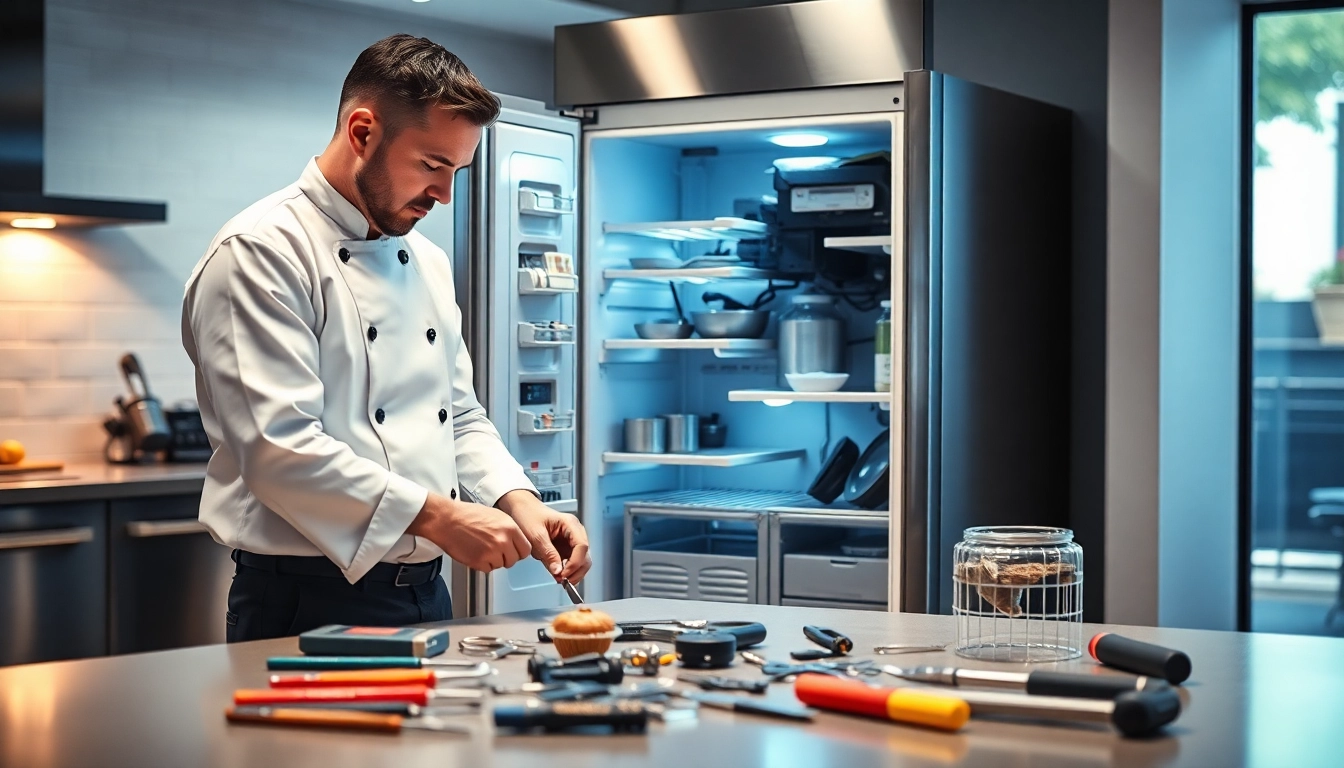Understanding Chef Base Refrigerators
Chef base refrigerators are essential appliances in any commercial kitchen, designed to provide both workspace and ample cold storage. These units facilitate efficient food preparation and preservation, ensuring that ingredients are readily accessible while maintaining optimal temperature conditions. With a compact structure that allows chefs to utilize the top surface for preparation, they serve as a dual-purpose solution in fast-paced culinary environments. However, like all equipment, chef bases require maintenance and occasional repairs to function optimally. For more information on chef base repair, understanding how these units work is imperative.
What is a Chef Base?
A chef base refrigerator is a refrigerated unit that integrates storage and a workspace. Typically found in professional kitchens, they consist of a flat top where chefs can place equipment like ovens or griddles, and underneath, they feature storage drawers or cabinets to keep a variety of ingredients cool. These multipurpose units maximize efficiency by combining food prep and storage in a single appliance, which is especially advantageous in restaurants and catering facilities where space is at a premium.
Common Uses in Commercial Kitchens
The utility of chef base refrigerators stretches beyond simple cooling. They are frequently used to store perishable ingredients, such as meats, vegetables, and dairy products, all within arm’s reach of the chef’s workstation. This proximity streamlines workflows, reduces movement, and helps maintain momentum in busy kitchen environments. Moreover, chef bases are often employed in food trucks, salad bars, and buffet setups where quick access to fresh ingredients is essential for serving high-quality meals in a timely manner.
Key Components of Chef Base Refrigerators
Understanding the components of chef base refrigerators is crucial for effective maintenance and repair. Key parts include:
- Compressor: Responsible for cooling the unit, it compresses refrigerant and circulates it through the system.
- Condenser Coils: These coils expel heat from the refrigerant, turning it back into a liquid state to restart the cycle.
- Evaporator Coils: Located inside the fridge, these coils absorb heat from the unit’s interior, cooling the air inside.
- Thermostat: A device that regulates the temperature inside the unit, ensuring it doesn’t get too warm or too cold.
- Storage Drawers: These are usually designed for easy access and organization, allowing quick retrieval of kitchen essentials.
Signs Your Chef Base Needs Repair
Recognizing early signs of malfunction can save commercial kitchens from more significant problems and costly repairs. Here are common indicators that your chef base may require immediate repair.
Common Symptoms of Malfunction
Several symptoms may signal that a chef base is not functioning correctly. Common issues include:
- Inadequate Cooling: If the interior temperature of the unit rises above safe levels, it may indicate compressor or coolant problems.
- Unusual Noises: Strange noises such as grinding or rattling can signify a malfunctioning compressor or a loose component.
- Frost Buildup: Excessive frost on the evaporator coils might indicate a defrosting issue, which can lead to inadequate cooling and inefficient energy use.
- Frequent Cycling: If the compressor cycles on and off more frequently than usual, it can lead to wear and tear, possibly requiring repairs.
Energy Efficiency Issues
Increased energy bills can also be a sign that a chef base refrigerator is malfunctioning. A unit that consumes more energy than necessary is often working harder due to an underlying issue, such as:
- Dirty condenser coils that hinder the cooling process.
- Worn-out door seals that permit warm air to enter the unit.
- Improper placement in areas that do not allow for sufficient airflow around the unit.
Impact on Food Safety
Maintaining the appropriate temperature in a chef base is vital for food safety. A malfunctioning unit can lead to temperature fluctuations that may cause food spoilage, leading to health risks for customers. Here are potential impacts:
- Pathogen Growth: Stored food in an improperly cooled chef base can become a breeding ground for bacteria, increasing the risk of foodborne illnesses.
- Flavor and Quality Degradation: Ingredients stored at unsafe temperatures can lose their freshness and flavor, ultimately affecting dish quality.
DIY Chef Base Repair Techniques
While some repairs require professional technicians, there are several DIY techniques kitchen staff can apply to troubleshoot minor issues and prolong the life of chef base refrigerators.
Basic Troubleshooting Steps
Before taking any significant actions, it’s crucial to run through some basic troubleshooting steps:
- Check Power Supply: Make sure the unit is plugged in and that the outlet is functioning.
- Inspect Temperature Settings: Ensure the thermostat is set to the appropriate temperature settings for food storage.
- Assess the Door Seals: Look for cracks or gaps in the door seals that can allow warm air inside.
Parts Replacement Guide
When it comes to DIY repairs, knowing how to replace essential parts is key. Here’s how to approach common replacements:
- Replacing Door Seals: Remove the old seals and clean the area. Install the new seals by pressing them into place, ensuring a tight fit.
- Changing Light Bulbs: If the internal lighting is dim or not working, safely replace bulbs by following the manufacturer’s guide.
- Swapping Out Thermostats: If the unit’s cooling is ineffective, replacing the thermostat can ensure better control of temperatures.
Tools Needed for Repairs
Having the right tools can streamline repair processes. Essential tools often include:
- Screwdrivers (flathead and Phillips)
- Multimeter for electrical testing
- Replacement parts specific to your unit
- Cleaning brushes for condenser coils
Professional Chef Base Repair Services
While many issues can be addressed with DIY solutions, there are scenarios where professional repair services are necessary. Knowing when to call in experts can save both time and money.
When to Call in Experts
Reach out to professional repair services when:
- The problem is related to the compressor or electrical systems.
- Multiple components are failing simultaneously.
- Attempting a DIY fix does not resolve the issue or the problem escalates.
Evaluating Service Quality
Finding reliable repair services can be challenging. Consider these factors while evaluating potential service providers:
- Experience and Certification: Check for licenses and certifications specific to commercial refrigeration.
- Customer Reviews: Read testimonials to gauge past customer satisfaction.
- Response Time: A quick response time can indicate good customer service and reliability.
Cost Considerations for Repairs
Understanding the potential costs associated with chef base repair aids in budgeting and planning:
- Labor Costs: Depending on the issue, repair costs can vary based on the technician’s hourly rate.
- Parts Costs: Replacement parts may be purchased directly or through service providers, which can impact total expenses.
- Service Call Fees: Some technicians charge a flat fee simply for evaluating the unit, regardless of whether repairs are made.
Maintenance Tips for Longevity
Preventing breakdowns through proper maintenance is crucial for ensuring the longevity of chef base refrigerators. Here are some best practices:
Regular Cleaning Practices
Cleaning the chef base refrigerator should be part of a regular maintenance schedule. Best practices include:
- Cleaning Coils: Dust and dirt on condenser coils can lead to inefficient cooling. Schedule regular cleanings to ensure they’re debris-free.
- Emergency Cleaning: If spills occur inside the unit, address them immediately to prevent mold growth.
- Daily Wipe Downs: A quick daily wipe of surfaces can promote hygiene and operational efficiency.
Importance of Temperature Monitoring
Maintaining an optimal temperature in your chef base unit is crucial for food safety. Implement practices like:
- Use of Thermometers: Regularly check the internal temperatures of refrigeration units to ensure compliance with food safety standards.
- Alarm Systems: Consider equipment with alarm systems that notify kitchen staff of temperature fluctuations.
- Calibrate Regularly: Periodically calibrate thermostats to guarantee accuracy in temperature readings.
Preventive Measures to Avoid Repairs
Implementing preventive measures greatly reduces the likelihood of a malfunction. Consider the following:
- Training Staff: Ensure that all staff are trained on proper use and care of the chef base refrigerator.
- Avoid Overloading: Excess weight can strain components, leading to premature wear and tear.
- Regularly Check Seals: Inspect and replace door seals to minimize energy loss.



